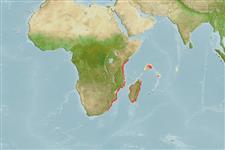>
Acropomatiformes (Oceanic basses) >
Pempheridae (Sweepers)
Etymology: Pempheris: Greek, pempheris = the name of a fish (Ref. 45335); eatoni: Named for Patrick Eaton who collected the holotype and five other adult specimens for this study.
Eponymy: Patrick Eaton, about whom we have failed to find more information than is contained in the original text. [...] (Ref. 128868), visit book page.
Environment: milieu / climate zone / depth range / distribution range
Ecologie
marien rifbewoner; diepte 1 - 15 m (Ref. 97766). Tropical
Verspreiding
Landen | FAO regio's | Ecosystemen | Voorkomen | Point map | Introducties | Faunafri
Western Indian Ocean: South Africa and Mozambique.
Grootte / Gewicht / Leeftijd
Maturity: Lm ? range ? - ? cm
Max length : 14.0 cm SL mannelijk / geslacht onbekend; (Ref. 97766)
Korte beschrijving
Determinatiesleutels | Morfologie | Morfometrie
Dorsale stekels (totaal) : 6; Dorsale zachte stralen (totaal) : 9 - 10; Anale stekels: 3; Anale zachte stralen: 38 - 44; Wervels: 25. This species is distinguished by the following characters: D VI,9-10 (usually 9); A III,38-44; pectoral rays 17-19; lateral-line scales 53-60; chest entirely with ctenoid scales; caudal fin scaled on about basal fourth; gill rakers 28-33; body depth 2.2-2.35 in SL; head length 3.3-3.4 in SL; orbit diameter 7.15-7.7 in SL; longest dorsal ray 3.7-4.05 in SL; pectoral-fin length 3.3-3.55 in SL; colour in alcohol gray-brown, scale edges narrowly gray, the dorsal fin brownish gray with an apical black spot, the color of anal fin like body basally, with a broad blackish middle zone, the margin narrowly whitish, the caudal fin is yellowish gray, paired fins are pale yellowish, the pectorals with a dark brown band across base, the iris is grayish blue (Ref. 97766).
Occurs in exposed rocky shores and often in small groups that shelter in caves or beneath ledges by day from depths as little as 1-2 m to at least 15 m. It has been observed to venture out of shelter at night to feed on planktonic invertebrates and larval fishes. It was also reported to have an extensive spawning season, judging from seeing shoals of juveniles through
most of the year. The gonads of adults were noted to be nearly always mature regardless of the time of year. It was also observed to swim slowly, when not stressed, propelling itself mainly by characteristic ‘sweeps’ of the pectoral fins (hence the common name sweeper). Smallest fully mature female specimen, 11.6 cm SL (Ref. 97766).
Levenscyclus en paargedrag
Maturiteit | Voortplanting | Paaien | Eieren | Fecunditeit | Larven
Randall, J.E. and B.C. Victor, 2014. Four new fishes of the genus Pempheris (Perciformes: Pempheridae) from the western Indian Ocean. J. Ocean Sci. Found. 12:61-83. (Ref. 97766)
Status op de Rode Lijst van het IUCN (Ref. 130435: Version 2024-2)
Gevaar voor de mens
Harmless
Gebruik door de mens
Tools
Speciale rapporten
Download XML
Internetbronnen
Estimates based on models
Fylogenetische diversiteitsindex (Ref.
82804): PD
50 = 0.5000 [Uniqueness, from 0.5 = low to 2.0 = high].
Bayesian length-weight: a=0.01380 (0.00591 - 0.03225), b=3.02 (2.83 - 3.21), in cm total length, based on LWR estimates for this Genus-body shape (Ref.
93245).
Trofisch niveau (Ref.
69278): 3.5 ±0.5 se; based on size and trophs of closest relatives
Weerstandsvermogen (Ref.
120179): Hoog, minimale populatieverdubbelingstijd minder dan 15 maanden (Preliminary K or Fecundity.).
Fishing Vulnerability (Ref.
59153): Low vulnerability (10 of 100).
